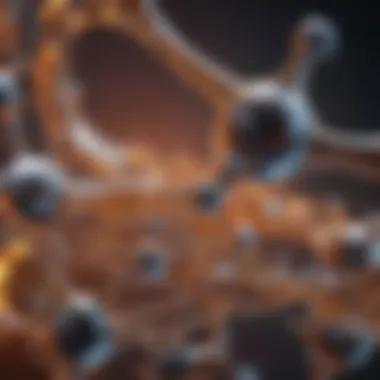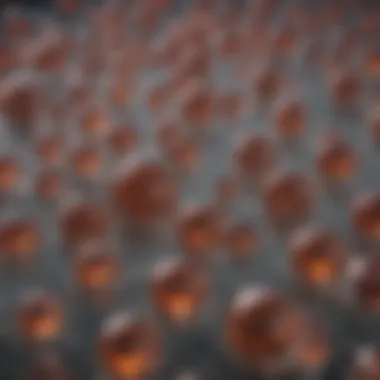Exploring the Chemistry and Applications of Imidazolium Ionic Liquids


Intro
Imidazolium ionic liquids have gained significant prominence in the field of chemistry. Their unique properties make them a subject of deep exploration. This section serves as the starting point for a thorough analysis of these solvents. The imidazolium cation, characterized by its stable structure, allows for a variety of applications across multiple domains, including industrial and environmental sectors.
Research Overview
Summary of Key Findings
Research indicates that imidazolium ionic liquids exhibit crucial properties such as low volatility, high thermal stability, and tunable solubility. These features enable their use in diverse chemical processes, from catalysis to extraction methods. Furthermore, studies show their potential as alternatives to traditional organic solvents, reducing environmental impact.
Research Objectives and Hypotheses
The primary objective is to elucidate the specific attributes that render imidazolium ionic liquids advantageous. Key hypotheses include the expectation that these liquids can serve as effective, environmentally friendly solvents in various applications. The examination spans their synthesis methods, structure-function relationships, and real-world applications.
Physical Properties of Imidazolium Ionic Liquids
Physical properties play a critical role in determining the applicability of imidazolium ionic liquids. Key characteristics include:
- Viscosity: Imidazolium ionic liquids typically have higher viscosity compared to conventional solvents, affecting their flow properties and reaction kinetics.
- Thermal Stability: Many imidazolium ionic liquids can retain stability under high temperatures, making them suitable for various industrial processes.
- Conductivity: Their ionic nature contributes to high electrical conductivity, which is vital for electrochemical applications.
The understanding of these properties paves the way for advancements in their utilization.
Methodology
Study Design and Approach
A comprehensive approach involving both experimental and theoretical perspectives will be undertaken. Experimental methods will focus on synthesizing various imidazolium ionic liquids to assess their properties. Theoretical models will simulate their behavior in different environments, aiding in understanding their functionality in diverse applications.
Data Collection Techniques
Data will be collected through a variety of techniques. These include physical property measurements, spectroscopic analysis, and computational simulations. Datasets will be gathered to allow for robust comparisons of different imidazolium ionic liquids that cater to improved applications.
The exploration of imidazolium ionic liquids opens new avenues for sustainable practices in chemical processes. Their unique features and capabilities provide possibilities for reducing environmental impact while maintaining efficiency.
Preamble to Ionic Liquids
Ionic liquids represent a significant advancement in the field of chemistry, characterized by their unique properties as salts that are liquid at relatively low temperatures. This topic is crucial to understanding the emergence and implications of imidazolium ionic liquids, a subclass of ionic liquids that have gained considerable traction in research and industrial applications. The significance of ionic liquids lies in their minimal volatility, thermal stability, and ability to dissolve a diverse range of materials, making them suitable for applications such as catalysis, extraction, and electrochemistry.
Definition and Composition
Ionic liquids are defined as salts that exist in a liquid state at temperatures below 100 °C. Their composition typically includes a combination of cations and anions, which can be tailored to exhibit specific properties. Imidazolium ionic liquids are formed from imidazolium cations, which are derived from imidazole, a five-membered nitrogenous heterocycle. The anion component can vary, often including species such as chloride, bromide, or larger anions like PF6 or Tf2N. This diverse composition allows for the manipulation of properties such as viscosity, solubility, and thermal stability, enabling various applications across different scientific disciplines.
Historical Development
The development of ionic liquids as a field can be traced back to the early 20th century, but it was not until the 1990s that significant interest began to form. The seminal work on imidazolium ionic liquids in 1992 by Wilkes and coworkers laid the framework for their broader investigation. Researchers quickly discovered that imidazolium ionic liquids exhibited unique qualities that surpassed traditional solvents. Notably, their low vapor pressure makes them attractive for environmentally-friendly processes. Over the past few decades, the field has expanded exponentially, with ongoing research focusing on synthesis methods, specific applications, and the exploration of novel ionic liquid families.
"Ionic liquids have transformed our understanding of solvent capabilities and opened up new pathways for sustainable chemistry."


The evolution of ionic liquids reflects a broader push toward environmentally sustainable practices within the chemical industry. Their unique properties and potential for a wide range of applications, from pharmaceuticals to materials science, demonstrate their importance in modern scientific inquiry.
Characteristics of Imidazolium Ionic Liquids
The characteristics of imidazolium ionic liquids play a crucial role in understanding their appeal and functionality in various applications. These properties determine their suitability for roles in both academic research and industrial processes. By examining the physical properties and thermal stability, one gains insight into why these ionic liquids are so widely utilized. Furthermore, knowing these characteristics assists researchers in selecting the right ionic liquid for specific tasks.
Physical Properties
Understanding the physical properties of imidazolium ionic liquids is essential because they directly influence the behavior and efficiency of these solvents in diverse applications. Key physical properties include viscosity, conductivity, and density.
Viscosity
Viscosity refers to the resistance of a fluid to flow. In the case of imidazolium ionic liquids, they generally exhibit a high viscosity due to their ionic nature. This characteristic can impact mixing and reaction rates in chemical processes. Higher viscosity can be beneficial in certain applications such as catalysis, where it may help in maintaining a specific reaction environment. However, this can also present challenges in processes requiring rapid fluid movement, as the efficiency may be hampered.
Understanding and controlling viscosity is therefore important for optimizing uses in organic synthesis.
Conductivity
Conductivity is the measure of a substance's ability to conduct electric current. Imidazolium ionic liquids show excellent electrical conductivity compared to traditional solvents. This makes them particularly attractive for applications in electrochemistry and battery technology. High conductivity is a key characteristic that allows for more efficient charge transfer in electrochemical systems. Nevertheless, the ionic liquid's structure affects its conductivity; certain imidazolium cations result in better conductivity than others. Choosing the right imidazolium ionic liquid can significantly enhance performance in electronic applications.
Density
Density is another vital physical property, defined as mass per unit volume. Imidazolium ionic liquids typically have a higher density than conventional organic solvents. This characteristic is important in processes such as liquid-liquid extraction, where density differences can facilitate phase separation. While high density can enhance extraction efficiency, it may also complicate handling and transportation. Hence, understanding the density of an imidazolium ionic liquid is critical for determining its practicality in various uses.
Thermal Stability
Thermal stability refers to a material's ability to withstand elevated temperatures without decomposing. Imidazolium ionic liquids display high thermal stability, which makes them suitable for high-temperature applications. Unlike many traditional organic solvents, these ionic liquids do not easily evaporate, reducing losses during heating processes. Additionally, their thermal stability allows for prolonged use under rigorous conditions, which is particularly useful in industrial applications such as catalytic reactions.
"Understanding the characteristics of imidazolium ionic liquids directly influences their practical applications in a range of fields."
Their advantages and challenges need to be carefully assessed to maximize their potential.
Synthesis of Imidazolium Ionic Liquids
The synthesis of imidazolium ionic liquids is a crucial aspect of this field, as it determines the purity, composition, and overall application of these substances. The methods used for synthesis can greatly affect the properties of the resultant ionic liquids. Various synthetic approaches exist, and understanding these can help researchers tailor imidazolium ionic liquids for specific uses in industries such as catalysis, pharmaceuticals, and environmental applications. Having efficient and reliable synthesis methods is essential not only for academia but also for industrial scalability and sustainability.
Common Synthetic Routes
Anion Exchange Methods
Anion exchange methods are significant in the synthesis of imidazolium ionic liquids, as they allow for the modification of the ionic liquid's properties through the substitution of anions. The key characteristic of this method is its ability to adapt existing ionic liquids to obtain desired functional groups. This flexibility is a major benefit for researchers looking to create ionic liquids with specific properties.
One unique feature of anion exchange methods is that they often enable the use of commercially available starting materials. This can lead to reduced costs and time in the production process. However, a disadvantage might be the residual amounts of the original anions, which can affect the purity and performance of the final product. Careful optimization of conditions is required to ensure high yields and minimal contamination.
Direct Synthesis
Direct synthesis involves the formation of imidazolium ionic liquids from the reaction of starting materials without the need for existing ionic liquids. This method provides a straightforward approach to produce tailored ionic liquids efficiently. A key characteristic of direct synthesis is its potential for higher purity levels, as there are fewer intermediate stages that can introduce contaminants.
The unique aspect of direct synthesis is its versatility. It can accommodate a broad range of precursors, which allows researchers to explore novel ionic liquid structures. However, one must consider that optimizing the reaction conditions can be challenging, as specific temperatures and reaction times are essential for achieving good yields. The direct synthesis method is popular due to its ability to generate pure compounds quickly and efficiently.
Purification Techniques


After synthesis, purification techniques for imidazolium ionic liquids are necessary to ensure that the final product meets the quality standards required for various applications. The common methods include crystallization, distillation, and ion exchange, each suited for different scenarios based on the nature of impurities and the target purity level. Purity is vital as it enhances the performance of the imidazolium ionic liquids in their intended applications. Hence, these purification techniques play a pivotal role in the overall effectiveness and reliability of the synthesized ionic liquids.
Applications in Organic Synthesis
Imidazolium ionic liquids have shown significant utility in organic synthesis, marking a prominent trend in contemporary chemistry. Their unique properties, such as low volatility and thermal stability, allow them to serve as both solvents and catalysts, which can enhance the efficiency of various chemical reactions. This section seeks to underline the specific benefits and considerations of employing imidazolium ionic liquids in organic synthesis, illuminating their transformative potential in the field.
Catalytic Roles
In recent years, imidazolium ionic liquids have gained attention as catalysts in numerous organic reactions. They perform exceptionally well in catalytic processes due to their ability to solvate reactants effectively, which can lower activation energy and thus increase reaction rates. By participating in the reaction mechanism, they can enhance product yields while reducing by-products, making them attractive alternatives to traditional solvents.
One of the prominent reactions where imidazolium ionic liquids excel is in the synthesis of fine chemicals. The use of these ionic liquids not only improves selectivity but also simplifies product isolation since they can often be recycled and reused. Moreover, when employed in catalytic hydrogenation or oxidation processes, they exhibit superior performance compared to conventional media.
"Imidazolium ionic liquids demonstrate promising catalytic capabilities, bridging efficiency and innovation in organic synthesis."
Aside from traditional catalytic applications, they are also being explored in more complex areas, such as multi-component reactions, where their tunable properties allow for tailored reactivity. An important consideration, though, is the choice of both the cation and anion in forming these ionic liquids, as different combinations can have greatly varying catalytic efficiencies.
Solvent Properties
The solvent properties of imidazolium ionic liquids play a pivotal role in organic synthesis. Unlike conventional solvents, they exhibit negligible vapor pressure, making them ideal for reactions where loss of solvent can be a critical issue. This property not only minimizes environmental concerns about volatile organic compounds but also leads to enhanced reaction safety and operational stability.
Their high polarity and ability to dissolve a wide range of organic and inorganic compounds enable imidazolium ionic liquids to act as adaptable media. They are particularly useful in promoting solubility for polar substrates, which might otherwise remain unreactive in traditional organic solvents. This solvation can lead to unique reactivity patterns, expanding the toolbox available to synthetic chemists.
Additionally, imidazolium ionic liquids can possess tunable viscosity and conductivity, which provides further advantages in reaction media performance. For example, a lower viscosity generally facilitates heat transfer and mixing, thus promoting even reaction conditions.
Environmental Impact and Sustainability
The exploration of imidazolium ionic liquids necessitates a critical evaluation of their environmental implications and sustainability. In the context of increasing global awareness regarding environmental conservation, the importance of understanding how these substances affect ecological systems cannot be overstated. As the potential applications of imidazolium ionic liquids expand, it becomes essential to examine their environmental footprint throughout their life cycle. This section seeks to address vital factors such as biodegradability, toxicity, and energy consumption during production and usage. Analyzing these elements not only highlights their benefits but also underlines the necessary considerations for utilizing imidazolium ionic liquids in a sustainable manner.
Biodegradability of Imidazolium Ionic Liquids
Biodegradability is one of the key aspects that affects the environmental sustainability of imidazolium ionic liquids. Generally speaking, ionic liquids have been scrutinized for their environmental compatibility. Many imidazolium ionic liquids exhibit limited biodegradability, which raises concerns about their potential impact on ecosystems when they are released into the environment. Studies indicate that some derivatives can persist for extended periods, thereby posing ecological risks.
Understanding the specific structural characteristics that influence biodegradability is important. For example, the nature of the anion can play a significant role in the biodegradation process. Research indicates that anions such as chloride have been observed to lead to a faster microbial breakdown compared to larger organic anions. Efforts are ongoing to develop imidazolium ionic liquids tailored for improved biodegradation and reduced environmental impact. These developments could provide viable solutions for ensuring that use of these substances aligns with sustainable practices.
Life Cycle Assessment
Conducting a life cycle assessment (LCA) of imidazolium ionic liquids presents a comprehensive view of their sustainability from production to disposal. LCA facilitates the identification of the environmental impacts associated with all stages of the liquid’s life.
- Raw Material Extraction: This step involves assessing the sustainability of the raw materials involved in synthesizing imidazolium ionic liquids. Concerns regarding the extraction processes and their ecological effects are vital to explore.
- Production Process: Production typically consumes a significant amount of energy and resources. An attractive aspect of imidazolium ionic liquids is the potential for improved efficiency in their synthesis. The identification of greener synthetic routes can significantly reduce the environmental toll.
- **Transportation and Distribution:**The environmental costs associated with the transportation of these materials to various locations should not be overlooked. Logistic solutions that minimize a carbon footprint can enhance sustainability efforts.
- End-of-Life Considerations: Evaluating how imidazolium ionic liquids are disposed of or treated is fundamental. A proper understanding aids in identifying strategies to mitigate potential ecological harm.
In summary, assessments of the life cycle of imidazolium ionic liquids help to inform researchers and industry professionals about sustainable practices. Considering both the positive and negative environmental impacts can optimize their use, ensuring a balance between innovation and responsibility in their applications.
Challenges and Issues
The exploration and utilization of imidazolium ionic liquids come with several challenges that must be acknowledged. These challenges influence their widespread application and acceptance, particularly in industrial settings. Understanding the issues of toxicity concerns and cost of production presents both obstacles and opportunities for researchers and industry professionals. Addressing these issues can lead to the development of safer and more sustainable chemical alternatives.
Toxicity Concerns


One prominent issue surrounding imidazolium ionic liquids is their potential toxicity. Research has shown that some imidazolium-based ionic liquids exhibit cytotoxic effects on various biological systems. The degree of toxicity can vary widely depending on factors such as the specific cation and anion combinations used. Certain imidazolium cations have demonstrated higher toxicological profiles, which raises important questions about safety in their application.
The critical evaluation of their toxicity is necessary not only for regulatory compliance but also for the practical implementation of these solvents in green chemistry. For example, the risk of environmental contamination due to improper disposal of ionic liquids is a key concern. Continuous research is essential to determine safer alternatives or modifications that can lower toxicity while maintaining desirable properties.
Additionally, understanding the mechanisms of toxicity can provide insights into how to engineer less harmful variants.
Cost of Production
The economic feasibility of imidazolium ionic liquids also presents significant challenges. The cost of production, which encompasses raw materials, synthesis processes, and purification steps, can be substantial. These factors may limit their usage, especially in commercial applications where profit margins are critical.
Streamlining synthesis methods is vital. Common synthetic routes, such as anion exchange and direct synthesis, can be optimized to lower costs. Finding efficient production pathways will not only make imidazolium ionic liquids more affordable but also encourage their adoption in wider applications.
Future Research Directions
The area of imidazolium ionic liquids is ripe for exploration. Given their unique properties and extensive range of applications, it becomes essential to chart future research directions. These directions do not only guide academic inquiry but also have significant implications for industries that rely on advanced materials and solvents. Understanding this potential can help in realizing the benefits of imidazolium ionic liquids, leading to innovations in diverse fields.
Innovative Applications
The search for new applications of imidazolium ionic liquids is critical. One promising area is their use in energy storage and conversion technologies. For instance, utilizing these ionic liquids as electrolytes in batteries can enhance performance. Not only do they improve energy density, but they also provide better thermal stability compared to traditional solvents. Conversely, incorporating them in fuel cells can lead to improved efficiency and reduced costs due to their favorable electrochemical properties.
Another domain of interest is their role in the extraction processes. Imidazolium ionic liquids can be tailored to selectively extract certain metals or organic compounds, making them invaluable in waste recycling and resource recovery. This adaptability leads to environmentally-friendly protocols that minimizes the use of hazardous solvents, thus advancing sustainability goals.
Moreover, the pharmaceutical industry is beginning to explore their utility. Imidazolium ionic liquids could act as excipients in drug formulations. Their dissolving power might aid in the bioavailability of poorly soluble drugs, which is a significant challenge in modern pharmacotherapy.
Improved Synthesis Techniques
Addressing the synthesis of imidazolium ionic liquids is also pivotal for fostering advancements in this field. Current production methods can often be costly and labor-intensive. Research into greener synthesis techniques could yield significant benefits. For instance, employing microwave-assisted synthesis can drastically reduce reaction times and energy consumption. This also limits waste generation, aligning with sustainable practices.
Another promising approach involves optimizing the reaction conditions for greater efficiency. For example, alterations in temperature and pressure during synthesis can influence yield and purity. This presents opportunities for researchers to devise methods that promise higher outputs with fewer by-products, enhancing economic feasibility.
Furthermore, exploring new precursors and reaction pathways may facilitate the creation of novel imidazolium ionic liquids with enhanced properties. Such advancements could lead to further breakthroughs in industrial applications, expanding the realm of possibilities.
Finale
The conclusion of this article encapsulates the essential insights on imidazolium ionic liquids, emphasizing their significance in contemporary science and technology. These ionic compounds stand out due to their unique characteristics, which confer advantages in numerous applications, making them an area of growing research interest. One of the key points is their role as efficient solvents and catalysts, which enables them to facilitate complex reactions that are often not feasible with traditional solvents.
Moreover, the environmental impact of imidazolium ionic liquids is another critical element to consider. Their biodegradability and potential for reduced toxicity compared to conventional solvents underscore their promise in green chemistry. Addressing these environmental considerations is vital, especially in light of increasing regulatory pressures and societal demands for sustainable practices in chemical manufacturing.
In summary, imidazolium ionic liquids represent a pivotal area of study for researchers aiming to innovate sustainable solutions in various fields. Their diverse applications in organic synthesis, coupled with their unique physical and chemical properties, position them as key players in the future of materials science and engineering.
"Understanding the full potential of imidazolium ionic liquids not only advances theoretical knowledge but also opens up new pathways for practical applications across disciplines."
Summary of Key Findings
Several important findings emerged from our examination:
- Versatility: Imidazolium ionic liquids serve diverse applications, particularly in organic synthesis, demonstrating their utility as solvents and catalysts.
- Unique Properties: They exhibit remarkable physical and thermal properties, including low volatility and high thermal stability, distinguishing them from traditional solvents.
- Sustainability: Concerns about their environmental impact are mitigated by their biodegradability and lower toxicity, making them more suitable for eco-friendly applications.
Addressing these key findings will help researchers and industry professionals make informed decisions regarding the implementation of imidazolium ionic liquids in various processes.
Implications for Future Research
Future research on imidazolium ionic liquids can address several crucial areas:
- Innovative Applications: Exploring new industrial applications in fields such as catalysis, electrochemistry, and separation technologies can yield significant advancements.
- Advanced Synthesis Techniques: Improving methodologies for the synthesis of imidazolium ionic liquids can enhance efficiency and reduce costs, paving the way for widespread adoption.















